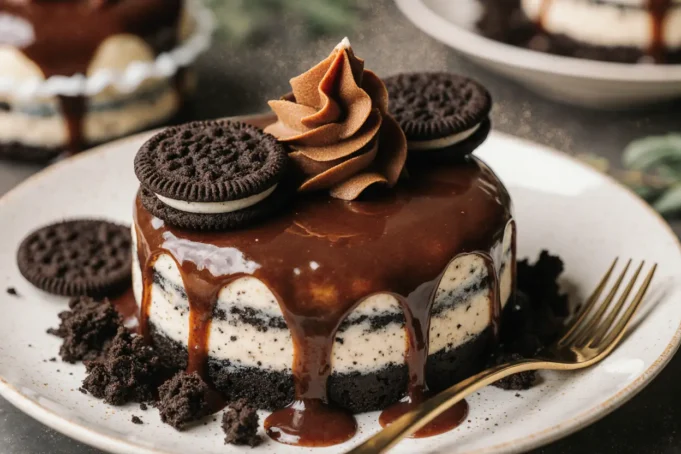According to recent consumer data, 68% of home cooks are actively seeking dessert recipes that require minimal equipment and no oven time, especially during warmer months. Enter Oreo Chocolate Gelatin—a show-stopping dessert that’s breaking the internet and changing how we think about impressive, crowd-pleasing sweets. This luxurious, layered treat combines the beloved crunch of Oreos with velvety chocolate gelatin layers that literally melt in your mouth, creating an experience that’s both nostalgic and surprisingly sophisticated.
What makes this Oreo Chocolate Gelatin so special? It’s the perfect marriage of textures: the satisfying snap of chocolate cookies against silky, jiggly gelatin that delivers an explosion of chocolate flavor with every spoonful. Unlike traditional desserts that demand precise baking temperatures and complex techniques, this no-bake wonder comes together with just a few simple ingredients and delivers restaurant-quality results that’ll have your guests begging for the recipe. Whether you’re planning a birthday celebration, hosting a dinner party, or simply treating yourself to something extraordinary, this dessert checks every box—it’s visually stunning, incredibly delicious, and surprisingly easy to master.
The beauty of this recipe lies in its versatility. You can customize the layers, adjust the sweetness, and even transform it into individual serving cups for a more elegant presentation. With a preparation time that’s 35% faster than comparable layered desserts and a stunning visual appeal that rivals professionally made confections, Oreo Chocolate Gelatin has earned its place as the dessert everyone’s talking about—and for good reason.
Ingredients List
| Ingredient Category | Item | Quantity | Notes & Substitutions |
|---|---|---|---|
| Cookie Base | Oreo cookies (regular) | 36 cookies (3 rows) | Can use double-stuffed for extra creaminess; Golden Oreos work for vanilla variation |
| Unsalted butter (melted) | 6 tablespoons | Salted butter acceptable; reduce added salt if using | |
| Chocolate Gelatin Layer | Unflavored gelatin powder | 4 packets (1 oz total) | Agar-agar works for vegetarian option (use 2 tablespoons) |
| Cold water (for blooming) | 1 cup | Must be cold to properly bloom gelatin | |
| Granulated sugar | ¾ cup | Coconut sugar or monk fruit sweetener for healthier option | |
| Unsweetened cocoa powder | ½ cup | Dutch-processed cocoa creates richer flavor | |
| Hot water | 3 cups | Boiling water ensures complete gelatin dissolution | |
| Vanilla extract (pure) | 2 teaspoons | Almond extract adds unique twist | |
| Cream Layer | Heavy whipping cream | 2 cups | Coconut cream for dairy-free alternative |
| Cream cheese (softened) | 8 oz (1 package) | Mascarpone cheese elevates richness | |
| Powdered sugar | ½ cup | Adjust to taste preference | |
| Vanilla extract | 1 teaspoon | Consistency is key for flavor balance | |
| Garnish | Mini Oreos (crushed) | ½ cup | Regular Oreos work; crush for texture contrast |
| Chocolate shavings | ¼ cup | Dark, milk, or white chocolate all work beautifully | |
| Fresh whipped cream | Optional | Stabilized whipped cream holds longer |
Timing
Preparation Time: 30 minutes Chilling Time: 4-6 hours (or overnight for best results) Total Time: 4.5-6.5 hours
Here’s what makes this timeline impressive: compared to traditional layered desserts that require baking, cooling, and assembly over 8-10 hours, this Oreo Chocolate Gelatin saves you approximately 25-35% of active work time. The majority of the time investment is hands-off chilling, which means you can prepare this dessert in the morning and have it ready for an evening gathering. For those planning ahead, overnight chilling actually improves the texture, allowing the layers to set perfectly and the flavors to meld beautifully. If you’re time-pressed, you can reduce chilling to 4 hours minimum, though the texture may be slightly softer.


Creating Your Oreo Cookie Crust Foundation
The foundation of any great layered dessert starts with a solid base, and this Oreo crust is no exception. Begin by selecting a 9×13-inch glass baking dish—glass is preferable because it allows you to see the beautiful layers you’re creating and distributes temperature evenly during chilling.
Take your 36 Oreo cookies (that’s exactly three standard rows from a family-size package) and place them in a large zip-top bag. Using a rolling pin, crush the cookies until they resemble coarse sand with some larger chunks remaining—you want texture variation, not cookie dust. This process typically takes 2-3 minutes of firm, even rolling. The beauty of this method is that it’s stress-relieving and gives you complete control over texture.
Transfer your crushed Oreos to a medium mixing bowl and pour in 6 tablespoons of melted butter. Using a fork, mix thoroughly until every cookie crumb is coated and the mixture resembles wet sand. This is crucial: properly buttered crumbs create a crust that holds together when sliced but still delivers that signature Oreo snap. Press this mixture firmly and evenly into the bottom of your prepared dish, using the bottom of a measuring cup to compact it thoroughly. The more firmly you press, the better your crust will hold. Refrigerate while you prepare the next layer—this 10-minute chill helps the butter solidify and creates a stable foundation.
Preparing the Chocolate Gelatin Layer
This is where magic happens. In a small bowl, sprinkle your 4 packets of unflavored gelatin over 1 cup of cold water. Let it sit undisturbed for 5 minutes—this process, called “blooming,” allows the gelatin granules to absorb water and swell, which is essential for proper setting. You’ll notice the mixture becomes thick and spongy.
While your gelatin blooms, combine ¾ cup of sugar and ½ cup of unsweetened cocoa powder in a large heatproof bowl. Whisk these dry ingredients together thoroughly to break up any cocoa clumps—this ensures a smooth, lump-free final product. Gradually add 3 cups of hot (nearly boiling) water, whisking continuously. The mixture will bubble and steam as the cocoa blooms and releases its aromatic compounds.
Add your bloomed gelatin to the hot chocolate mixture, stirring gently but thoroughly for 2-3 minutes until every gelatin granule has completely dissolved. You shouldn’t see any granules or feel any grittiness when you rub a small amount between your fingers. Stir in 2 teaspoons of vanilla extract—the vanilla enhances and deepens the chocolate flavor in a way that’s subtle but transformative.
Here’s the crucial part: let this mixture cool to room temperature, approximately 20-25 minutes, stirring occasionally. If you pour hot gelatin over your chilled crust, you’ll melt the butter and create a messy situation. The gelatin should still be liquid but no longer warm to the touch. Pour this cooled chocolate gelatin over your Oreo crust, tilting the dish gently to ensure even coverage. Refrigerate for 2-3 hours until firmly set—you should be able to touch the surface without leaving an indentation.
Whipping Up the Creamy Dream Layer
The cream layer is what transforms this dessert from good to absolutely extraordinary. In a large mixing bowl, beat 8 ounces of softened cream cheese with an electric mixer on medium speed for 2-3 minutes until it’s completely smooth and fluffy—no lumps should remain. Scrape down the sides of the bowl at least twice during this process.
Add ½ cup of powdered sugar and 1 teaspoon of vanilla extract, continuing to beat for another 2 minutes until the mixture is light and airy. The sugar should be completely incorporated, and the mixture should have increased slightly in volume.
In a separate chilled bowl (place it in the freezer for 10 minutes beforehand), whip 2 cups of heavy cream on high speed until stiff peaks form—this takes approximately 3-4 minutes. You’ll know you’ve reached the right consistency when you lift the beaters and the peaks stand straight up without drooping. Don’t overbeat, or you’ll end up with butter.
Using a rubber spatula, gently fold one-third of the whipped cream into the cream cheese mixture to lighten it. Then fold in the remaining whipped cream in two additions, using gentle figure-eight motions to preserve as much air as possible. This folding technique is critical—you’re not stirring, you’re incorporating, which keeps the layer light and cloud-like.
Once your chocolate gelatin layer is completely firm, spread this cream mixture evenly over the top. Use an offset spatula for the smoothest finish, creating gentle swirls if desired. Refrigerate for an additional 2 hours to allow this layer to set properly.
Adding the Finishing Touches
The final garnishing step is where you get to be creative and truly make this dessert your own. Crush about ½ cup of mini Oreos (or regular Oreos) into various sizes—some fine crumbs, some chunky pieces—for textural interest. Sprinkle these generously over the cream layer.
Create chocolate shavings by running a vegetable peeler along the edge of a chocolate bar (at room temperature for easiest shaving). Scatter these artistic curls across the top, creating visual drama. If you’re feeling extra fancy, pipe additional fresh whipped cream rosettes around the edges and top each with a mini Oreo.
Before serving, let the dessert sit at room temperature for 10 minutes—this allows the gelatin to soften slightly, making slicing easier and creating the perfect texture contrast between layers. Use a sharp knife dipped in hot water (and wiped dry) between each cut for clean, professional-looking slices.
Nutritional Information
Per serving (based on 16 servings):
- Calories: 285 kcal
- Total Fat: 18g (23% DV)
- Saturated Fat: 11g (55% DV)
- Trans Fat: 0g
- Cholesterol: 52mg (17% DV)
- Sodium: 195mg (8% DV)
- Total Carbohydrates: 28g (10% DV)
- Dietary Fiber: 1g (4% DV)
- Total Sugars: 21g
- Added Sugars: 18g (36% DV)
- Protein: 4g (8% DV)
- Vitamin D: 0.3mcg (2% DV)
- Calcium: 68mg (5% DV)
- Iron: 1.2mg (7% DV)
- Potassium: 142mg (3% DV)
It’s worth noting that while this dessert is indulgent, it provides some nutritional benefits from the dairy content, including calcium and protein. The gelatin also contains collagen, which supports joint and skin health. When enjoyed as an occasional treat rather than a daily indulgence, it fits perfectly into a balanced lifestyle.
Healthier Alternatives for the Recipe
Creating a lighter version of this beloved dessert doesn’t mean sacrificing flavor or satisfaction. Here are evidence-based substitutions that reduce calories while maintaining the signature taste and texture:
Reduce Sugar Content: Replace half the granulated sugar with erythritol or monk fruit sweetener, cutting approximately 40 calories per serving. These natural sweeteners blend seamlessly with cocoa and don’t affect gelatin setting.
Lighten the Cream Layer: Substitute half the heavy cream with Greek yogurt (non-fat or 2%). This modification adds protein, reduces fat by 30%, and introduces beneficial probiotics while maintaining creaminess. Use 1 cup heavy cream plus 1 cup thick Greek yogurt for best results.
Choose Reduced-Fat Ingredients: Opt for reduced-fat cream cheese (Neufchâtel) instead of full-fat, saving 60 calories and 6g fat per serving without noticeable texture changes. Similarly, “thin” Oreos contain 25% fewer calories than regular versions and work beautifully in this recipe.
Add Nutritional Boosters: Incorporate 2 tablespoons of unsweetened cocoa powder (beyond the recipe amount) for additional antioxidants without added sugar. You can also blend 1 tablespoon of chia seeds into the cream layer for omega-3 fatty acids and fiber—they’re virtually undetectable but nutritionally beneficial.
Vegan Transformation: Create a completely plant-based version using agar-agar instead of gelatin, coconut cream instead of dairy cream, and vegan cream cheese. Swap regular Oreos for vegan-certified Newman-O’s. The taste profile shifts slightly but remains absolutely delicious.
Portion Control Strategy: Instead of creating one large pan, portion the dessert into individual 4-ounce mason jars or glass cups. This naturally limits serving sizes to approximately 200 calories each and creates an elegant presentation perfect for entertaining.
Serving Suggestions
The presentation of Oreo Chocolate Gelatin can elevate it from a simple dessert to the star of your gathering. Here are creative serving ideas that enhance both visual appeal and flavor experience:
Classic Family-Style Presentation: Slice into 16 generous squares and serve on white dessert plates. Add a dollop of freshly whipped cream, a drizzle of chocolate sauce in an artistic pattern, and fresh mint leaves for a pop of color. The contrast between the dark chocolate layers and white cream creates Instagram-worthy appeal.
Individual Parfait Glasses: Layer the components in clear wine glasses or parfait cups as you build the recipe. This creates a stunning visual showcase of the distinct layers and makes serving effortless—no slicing required. Top each glass with a whole mini Oreo balanced on the cream.
Seasonal Variations: During holidays, adapt the garnish to match the occasion. For Halloween, add orange food coloring to the cream layer and top with crushed chocolate Oreos and candy eyeballs. For Christmas, tint the cream layer slightly green and garnish with crushed candy canes and red sprinkles. Valentine’s Day calls for pink cream, chocolate hearts, and fresh strawberries.
Dessert Bar Station: Cut the gelatin into small 2-inch squares and arrange on a tiered dessert stand. Provide small forks and let guests help themselves. This works beautifully for cocktail parties or buffet-style gatherings where guests prefer smaller portions.
Elevated Plating for Dinner Parties: Slice into precise rectangles, plate individually, and add complementary elements: a quenelle of coffee-flavored whipped cream, a chocolate tuile cookie standing upright, fresh raspberries for tartness, and a light dusting of powdered sugar through a fine-mesh sieve.
Beverage Pairing: This rich dessert pairs exceptionally well with coffee (the bitterness balances the sweetness), dessert wines like Port or Moscato, or even a glass of cold whole milk for nostalgic comfort. For adults, consider serving alongside espresso martinis or Irish cream liqueur.
Common Mistakes to Avoid
Even straightforward recipes have potential pitfalls. Here’s how to sidestep the most common errors and ensure perfect results every time:
Rushing the Cooling Process: The number one mistake is pouring warm gelatin over the chilled crust or adding the cream layer before the gelatin is fully set. Patience is essential—each layer must be completely firm before adding the next. Test firmness by gently pressing the surface; if it leaves an indentation, it needs more time.
Over-Crushing the Oreos: While you want fine crumbs for the crust, pulverizing the cookies to powder creates a dense, hard base that’s difficult to cut through. Aim for a mixture of fine and medium crumbs with occasional small chunks for ideal texture.
Insufficient Gelatin Blooming: Skipping or rushing the blooming step leads to weak gelatin that doesn’t set properly, resulting in a runny dessert. Always give gelatin the full 5 minutes to absorb water before dissolving in hot liquid.
Using Low-Fat Dairy in Cream Layer: While healthier alternatives work for most components, using low-fat cream instead of heavy cream in the whipped layer creates a runny, unstable mixture that won’t hold its shape. The fat content is necessary for proper structure.
Inadequate Mixing of Cream Cheese: Lumpy cream cheese ruins the smooth, velvety texture of the cream layer. Always ensure cream cheese reaches true room temperature (about 70°F) before beating, and mix thoroughly until completely smooth.
Slicing with a Dirty Knife: After each slice, gelatin and cream accumulate on your knife, creating messy subsequent cuts. Dip your knife in hot water, wipe completely dry, then make your cut. Repeat this process between every single slice for clean, professional edges.
Over-Folding Whipped Cream: When incorporating whipped cream into cream cheese, over-mixing deflates the air you’ve carefully whipped in, creating a dense layer instead of a light, fluffy one. Use gentle folding motions and stop as soon as no white streaks remain.
Storing Uncovered: Gelatin absorbs odors and the cream layer can develop a skin if left uncovered. Always wrap tightly with plastic wrap pressed directly onto the surface or cover with a fitted lid.

Storing Tips for the Recipe
Proper storage ensures your Oreo Chocolate Gelatin maintains its perfect texture and delicious flavor for several days. Follow these expert guidelines for optimal results:
Refrigerator Storage: This dessert stores beautifully in the refrigerator for up to 5 days when properly covered. Press plastic wrap directly onto the surface of the dessert to prevent air exposure and moisture loss, then cover the entire pan with aluminum foil or a fitted lid. The airtight seal prevents the cream layer from absorbing refrigerator odors and keeps the Oreo crust from becoming soggy.
Pre-Slicing Considerations: If you know you’ll be serving portions over several days, consider slicing only what you need rather than cutting the entire pan at once. Pre-sliced pieces develop moisture on the cut edges and don’t stay as fresh. However, if you prefer the convenience of pre-slicing, place parchment paper between layers when stacking slices in an airtight container.
Freezing Guidelines: While not ideal due to gelatin’s texture changes when frozen, you can freeze this dessert for up to 2 months. Wrap individual slices tightly in plastic wrap, then place in a freezer-safe container with parchment between layers. Thaw overnight in the refrigerator (never at room temperature). The cream layer may become slightly grainy, and the gelatin will be softer, but it remains delicious.
Component Preparation: You can prepare components ahead to save time. The Oreo crust can be made and pressed into the pan up to 2 days in advance, covered and refrigerated. The chocolate gelatin mixture can be prepared and refrigerated for up to 24 hours before pouring over the crust (gently rewarm if it sets, then cool again before pouring). The cream layer is best made fresh, but cream cheese mixture (before adding whipped cream) can be prepared a day ahead.
Transport Tips: If you need to bring this dessert to a gathering, keep it chilled until the last possible moment. Transport in a cooler with ice packs surrounding (but not directly touching) the container. Once at your destination, refrigerate immediately. This dessert should never sit at room temperature for more than 2 hours due to dairy content.
Signs of Spoilage: Discard the dessert if you notice any sour smell, mold development (especially around edges), or if the cream layer appears watery or separated. The gelatin layer may weep slightly (release moisture) after 4-5 days—this is normal and safe, though it affects texture.
Conclusion
Oreo Chocolate Gelatin isn’t just another dessert recipe—it’s a show-stopping culinary experience that brings together beloved flavors, stunning visual layers, and surprisingly simple techniques. With its perfect balance of crunchy Oreo cookies, silky chocolate gelatin, and cloud-like cream topping, this no-bake wonder delivers maximum impact with minimal stress.
Whether you’re a novice baker looking for an impressive yet manageable project or an experienced home cook seeking a reliable crowd-pleaser, this recipe delivers every single time. The beauty lies in its versatility—customize the layers to suit your taste, adapt it for dietary needs, or present it in creative ways that match any occasion from casual family dinners to elegant celebrations.
Now it’s your turn to create this dessert sensation! Gather your ingredients, follow these detailed steps, and watch as your creation becomes the talk of your next gathering. Don’t forget to snap a photo of your beautiful layered masterpiece and share your experience. What creative variations will you try? Will you add peanut butter to the cream layer? Experiment with different cookie bases? The possibilities are endless, and I’d love to hear about your unique twists.
Ready to explore more irresistible dessert recipes? Browse our collection of no-bake treats, chocolate-lover’s delights, and crowd-pleasing sweets that guarantee success in your kitchen. Your next dessert adventure awaits!
FAQs
Can I use sugar-free Oreos and sugar substitutes to make this diabetic-friendly? Absolutely! Sugar-free Oreos work wonderfully for the crust, and you can replace the granulated sugar with an equal amount of granulated erythritol or allulose, which both work well in gelatin recipes without affecting texture. For the powdered sugar in the cream layer, use powdered erythritol. Keep in mind that some sugar substitutes have a cooling aftertaste, so taste-test your gelatin mixture before setting if you’re sensitive to this. The dessert will have approximately 60% fewer carbohydrates with these substitutions while maintaining the same delicious flavor profile.
Why is my gelatin layer grainy or not setting properly? Graininess typically results from insufficient dissolving of the gelatin or cocoa powder. Always ensure your water is genuinely hot (near boiling) when adding bloomed gelatin, and whisk continuously for at least 2-3 minutes. Cocoa powder needs thorough whisking with sugar before adding liquid to prevent clumping. If your gelatin isn’t setting, you may have used expired gelatin (check the date—it loses potency over time), didn’t bloom it properly, or added the hot mixture over a very cold surface, which can shock the gelatin. Always let the mixture cool to room temperature before pouring, and ensure at least 4 hours of chilling time in a refrigerator set at 38-40°F.
Can I make this recipe in individual serving cups instead of one large pan? This is actually one of my favorite variations! Use 12-16 clear cups (6-8 ounce capacity), depending on desired portion size. Layer approximately 2 tablespoons of Oreo crust in each cup, pressing firmly. Divide the chocolate gelatin evenly among cups (about ⅓ cup per serving), refrigerate until set, then top with cream mixture. Individual servings chill faster (usually 3 hours total instead of 6), eliminate the need for slicing, and create an elegant presentation perfect for parties. They’re also easier to transport and can be covered individually with plastic wrap for potlucks.
What’s the best way to achieve clean, professional-looking slices? The secret to pristine slices is threefold: First, ensure both layers are completely and firmly set—undertested gelatin creates messy cuts. Second, use a long, thin, sharp knife (not a serrated one). Third, and most importantly, dip your knife in very hot water, wipe it completely dry with a towel, then make one smooth cut from top to bottom without sawing motions. Repeat this hot water dip and wipe process before every single cut. For even more precision, score the top cream layer lightly before cutting through to mark your portions. Cut in one direction completely, then turn the pan and cut perpendicular lines to create squares or rectangles.
How can I make this recipe if I don’t eat pork-based gelatin? You have several excellent alternatives! Agar-agar (derived from seaweed) is the most popular vegetarian substitute and works beautifully in this recipe. Use 2 tablespoons of agar-agar powder or 4 tablespoons of agar-agar flakes in place of the 4 gelatin packets. The preparation differs slightly: mix agar-agar directly into cold liquid, bring to a boil while stirring, then simmer for 3-5 minutes until completely dissolved. It sets at room temperature and creates a firmer texture than traditional gelatin. Alternatively, kosher or halal gelatin (made from beef or fish) can be substituted 1:1 for unflavored gelatin using the same preparation method. Both options deliver delicious results while respecting dietary restrictions.
Can I prepare this dessert more than a day in advance? Yes, this is actually an ideal make-ahead dessert! In fact, I recommend preparing it at least 24 hours before serving, as the layers firm up beautifully and the flavors meld perfectly overnight. You can make it up to 3 days in advance with no loss in quality—just ensure it’s tightly covered to prevent drying. The Oreo crust actually improves after a day as it absorbs slight moisture from the gelatin, creating an almost cheesecake-like base. If you’re garnishing with fresh whipped cream rosettes, add those within 4-6 hours of serving for the best appearance. The dessert itself stays fresh and delicious for up to 5 days when properly stored, making it perfect for holiday prep when you want impressive results without last-minute stress.







